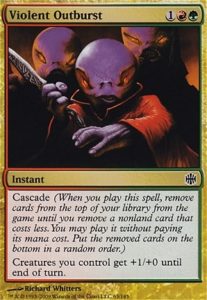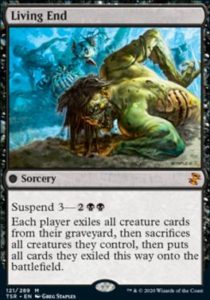If you are new here, don’t forget to check our Discord Channel. It’s free for everyone!
Introduction
On August 26th there was a scheduled ban announcement. While everyone was sure about the Nadu’s fate, the Grief ban surprised most people. The reactions were mixed – players who were sick of turn one Grief were thrilled, while the ones who relied on the black Elemental were mad, angry, disappointed, and so on. It was true that Grief decks were not dominating in the post-MH3 Modern, so the ban could look unneeded or at least belated compared to the Scam era, but Nadu was really good at keeping discard in check, so we don’t know whether Grief would come back to terrorise Modern after the bird was caged. We could talk about it for hours, so let’s focus on how the metagame adapted to the change.

Right after the ban, most commentators (including myself) were sure that the three Grief decks – Goryo, Necrodominance, and Living End – got a huge hit and it’s uncertain if they survive in the meta. Among them, Living End was considered to be in the worst position, and for sure dead. To be honest with you, I was one of the doubters, but I’m happy to announce that I was wrong. In this article, I’ll talk about where I made a mistake during analysis and what makes Living End so resilient to bans. To properly answer these questions, let’s come back to the roots.
Why is Living End good at all?
It may look weird to you that I want to describe the core strengths of a deck that has been around forever, but I have a feeling that most of you are missing the point and focus too much on stuff that’s a feature at best. Living End was always about the card and tempo advantage. The goal is to put a few overcosted creatures into play and get rid of the opponent’s board while doing so. After you set up a clock, slow down whatever the opponent tries to do with the free spells you drew while cycling – that’s the definition of Living End’s gameplan. What’s important, using cycling means that we don’t lose cards while setting up, so once we resolve the namesake card we virtually drew a few extra cards and used them to set up the pressure. In the past, there wasn’t any good use for the extra cards drawn. Nowadays, we have access to pitch spells that interact with the opponent and since we create card advantage, they are effectively free – it’s hard to find a deck that would use Subtlety, Force of Negation or Endurance better. What type of interaction we pack is less important – as long as it trades resources with the opponent for zero mana, and can do at least something meaningful against most of the decks from the meta, it’s good for Living End. Double Grief was never mandatory – it was nice to have it, but it wasn’t essential for the plan. Resolving Living End is.
So you know why Living End is a good deck. But how can it stay good even after WOTC decided to strip it of its powerful and flexible tools? Firstly, let’s analyze the Violent Outburst ban and how the Living End community reacted. After that, we’ll mirror the process with the Grief ban.
What happened after the Violent Outburst ban and what can we learn from it?
When I think about the whole Living End’s development after the Grief ban, I have flashbacks to the journey the archetype had to take after the Violent Outburst got axed. At first, no one believed the deck could be good without an instant speed cascade. People tried some very exotic builds with Bloodbraid Marauders, 4c with Demonic Dread, used cards like Press the Enemy, As Foretold, and so on. After a few weeks, it turned out that just the easiest swap: Ardent Plea instead of Outburst and a few adjustments in the manabase was enough to put the deck back on the map. The stock Outburst list was stock for a reason – it was the best at dealing with the threats and the hate – so it was extremely unlikely that all of the sudden cards that were bad in the past would be good now. Also, the main strength of Living End was not in going off at instant speed (although it was important against some decks), it was in how devastating the aftermath is for your opponent.

Once I realised that, I was even more surprised that I fell into the same trap after the second ban. Grief had its role to fulfil, it was useful against many cards the opponent could have, but it wasn’t a centrepiece of the deck. Personally I believe that because of the Outburst ban we got earlier this year, it took less time for the Living End pilots to understand this very basic knowledge that Grief is more of a feature than a fixture. We already switched to Endurance/Commandeer in the maindeck and I can see going in a few other directions. There’s still time to test some ideas, for example, people are experimenting with a few cards that couldn’t compete with Grief, but they hope to reinvent the wheel by adding them to the mix. Some of the ideas are solid (for example Colossal Skyturtle as an interaction that’s also green so can be pitched to Endurance, Titanoth Rex is good against Energy and Eldrazi, etc.), others are hit or miss (Endurance looks either spectacular or embarrassing and I don’t know if it’ll stay in the maindeck for good or Commandeer maindeck – I love it in the very heavy Ring meta, but it’s clunky otherwise) or just bad (Press the Enemy as a way to play Living End at instant speed that just doesn’t fit into the cascade plan at all, please don’t play it). I assume that in three months from now, most lists will differ very slightly from the Grief days.
So how should the deck be built after the Grief ban?
Grief had its moments and I don’t want to deny that it was an important part of the plan. I pointed out its biggest strengths:
- It was nearly always useful. 98% decks in the format will work worse after you discard their best card. Grief was the widest answer we had, which made its floor much higher compared to blue pitch spells.
- It was a disruption that could later pressure the opponent. I’m pretty sure we would play Unmask in Living End. Giving it a decent body and another peek at their hand after Living End resolved broke the card for us.
- It was the only clean answer against a number of problems. Some cards are really hard to fight on the stack: Consign to Memory, Flusterstorm, Dovin’s Veto, etc., and Grief deals with them well.
- It made drawing Living Ends somewhat useful.
But the lack of Grief doesn’t mean there aren’t any solid replacements or that it will be impossible to play the deck without it. We’ll just have to adapt to a few things and maybe use different tools to combat certain strategies or hate cards.
- The biggest upgrade is that we won’t have to play Architects of Will. It was always the worst cycler and I’m glad I can cut it from the deck. Now we can come back to Striped Riverwinder, Titanoth Rex, or any other better cycler we can find.
- Discard also was getting worse and worse in the Modern where there are so many high impact cards in decks. So even with Grief legal I’d rather cast blue pitch spells which trade up on mana were.
- The lack of Grief means we can play some other zero mana interaction. Right now, there are two popular trends. The first one opts for Endurance (with a few more green cards in the package to increase the odds of pitching it) which makes Phlage matchups, Storm, and Goryo much better. The second one is Commandeer – an answer to the metagame infested by The One Ring. I expect their numbers to fluctuate in the next few months. These additions can even make some matchups better for the post Grief ban version – for example against Goryo, Endurance will be more impactful than Grief. But regardless of which version you choose, you’ll get a card that will be more high-variance compared to an always solid Grief.
- The biggest challenge for Living End without Grief will be blue matchups. In theory, it’s possible to Commandeer the counter, but it takes more cards to pitch and doesn’t solve the Consign to Memory problem. The only solution is to play more three mana cards to address this problem. For example, Teferi, Time Raveler becomes better because it’s the only real answer to Consign right now. However, playing too many three drops will stop our deck from functioning properly, and I haven’t found a good balance of them just yet.

Conclusion
The lack of Grief won’t push Living End out of the metagame. The main concept of the deck – establish a dominating board presence and disrupt your opponent with pitch spells until you kill them – stayed intact and, at least for now, it should stay in the metagame. The main thing that changed is that the deck became worse against decks with countermagic. You can still win games with multiple cascades, Mystical Dispute, Teferi, or even a flash game plan, there’s just one less line of defence. Some combo matchups can also become worse since discard was good against them. But again, any of the replacements will be somewhat impactful as well – it can be Flare of Denial, Endurance, Commandeer, or anything else you can come up with.
On the other hand, some matchups may become better compared to the Grief era – it comes down to how the replacement card will affect the given matchup. For example, with Endurance Goryo feels winnable and Phlage is manageable, Commandeer can solo The One Ring decks, and so on. But because all of these effects are narrower, the metagaming and choosing the right cards for your flex slots will matter more.
Violent Outburst and Grief bans narrowed Living End’s range – from being a Swiss Army knife that could handle everything to the deck that’s good in certain metagames and bad in others. But overall, the power level of the deck is high enough to compete in current Modern and as long as you can resolve Living End on time and damage the opponent’s plan by doing so, it will be a solid choice moving forward.
